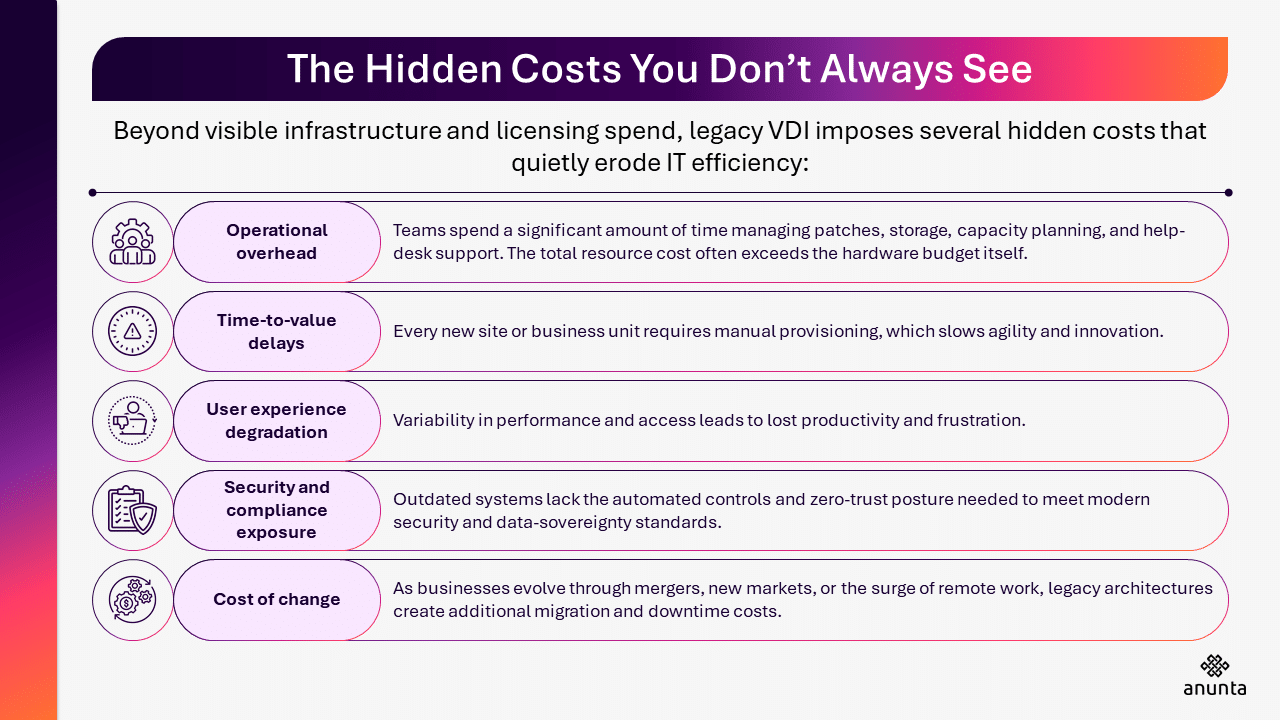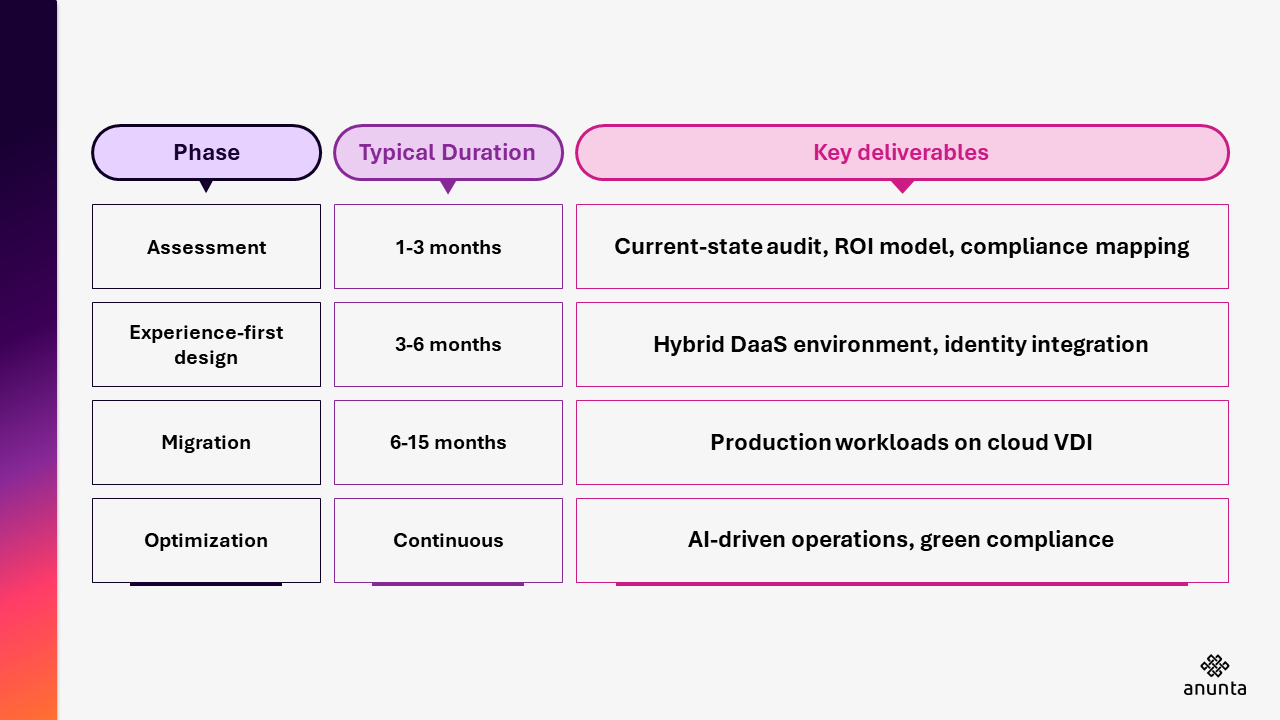Across the GCC, enterprises are accelerating their digital transformation to meet new business demands, regulatory requirements, and the realities of a hybrid work environment. Yet, many organizations still rely on legacy virtual desktop infrastructure (VDI) environments, which were designed for a very different set of business needs.
While these platforms once formed the backbone of enterprise IT, they now consume resources, limit agility, and increase the cost of delivering secure, consistent user experiences. Understanding the actual total cost of ownership (TCO) of legacy VDI is the first step for CIOs seeking to modernize and align technology with the region’s growth pace.
What “Legacy VDI” Means in 2026
Legacy VDI typically refers to traditional on-premises desktop delivery models that rely on dedicated hardware, fixed licensing, and manual management. In many GCC organizations, this has led to:
- High capital expenditure for infrastructure that is under-utilized most of the year.
- Rigid capacity that cannot scale with business cycles.
- Operational complexity caused by siloed tools and manual updates.
- Slow provisioning that delays user onboarding and project timelines.
For fast-growing GCC enterprises, especially those in regulated sectors such as finance, government, and energy, these challenges are no longer sustainable.

Each of these factors adds invisible pressure on IT budgets and limits the agility GCC enterprises now require.
Why GCC Organizations Feel It More Deeply
The financial and operational impact of legacy VDI is amplified in the Middle East because of:
- Rapid digital expansion under Saudi Vision 2030 and UAE Smart Government initiatives that demand scalable, cloud-ready infrastructure.
- Strict regulatory compliance requirements in industries such as BFSI and oil and gas, where fragmented VDI setups increase risk and audit cost.
- The evolution of hybrid work means employees expect seamless, secure access from any device.
- Higher operational costs for space, cooling, and energy related to on-premises data centres.
The longer enterprises maintain legacy VDI, the higher the opportunity cost of not modernizing.
Can the enterprises modernize from legacy VDI?
GCC (Gulf Cooperation Council) countries can modernize from legacy Virtual Desktop Infrastructure (VDI) by embracing cloud-native, AI-driven, and hybrid digital workspace solutions that align with local data compliance frameworks. Modernization requires integrating flexibility, security, and scalability while ensuring alignment with national digital visions such as Saudi Vision 2030 and UAE Digital Government Strategy 2025.
- Transition to Cloud PC and DaaS Models
Migrating from on-premises VDI to Cloud PC solutions, such as Horizon Cloud Standard Subscription or Omnissa Horizon Cloud, provides elasticity and simplified management. Cloud PCs support hybrid and frontline workforce needs, lowering infrastructure costs and aligning with regional compliance regulations.
- Adoption of Multi-Cloud and Edge Environments
GCC enterprises are leveraging Horizon Cloud and local sovereign clouds to strike a balance between latency, compliance, and data residency. Multi-cloud models enhance reliability while enabling centralized workspace management across various sectors, including finance, energy, and healthcare.
- Microservices and API-Driven Architecture
Encapsulating legacy VDI management systems with APIs and microservices enables gradual modernization without requiring a complete system replacement. This accelerates automation, reduces downtime, and integrates modern ITSM and IAM solutions.
- Security-First Workspace Re-engineering
Implementing a zero-trust architecture with encrypted connections (TLS 1.3, AES-256), identity federation, and real-time threat monitoring ensures compliance with GCC cybersecurity mandates, such as the UAE’s NESA and Saudi Arabia’s SDAIA frameworks.
- Hybrid and Phased Modernization Strategy
Given the scale of enterprise infrastructure, a hybrid approach that rehosts some systems, refactors others, and replaces obsolete components helps strike a balance between ROI and operational continuity. This aligns the modernization pace with business objectives.
By evolving from legacy VDI toward cloud-first, secure, and AI-integrated digital workspaces, GCC enterprises can build resilient, compliant, and high-performance employee environments. This modernization supports economic diversification agendas and positions the Gulf as a leading hub for digital innovation across the EMEA region.
The Path to Transition
Modernization does not need to be disruptive. Anunta’s proven frameworks help enterprises evolve at their own pace:
- Assessment and benchmarking: Identify current VDI costs, performance bottlenecks, and security gaps to inform informed decisions.
- Experience-first design: Define user personas, application needs, and endpoint diversity.
- Phased migration: Deploy pilot workloads, validate performance, and scale gradually.
- Ongoing optimization: Utilize analytics and automation to enhance user experience and cost efficiency continually.

This roadmap reflects the hybrid modernization trend across GCC enterprises, combining sovereign cloud investment, AI-enabled digital experiences, and sustainability mandates to create future-ready, compliant digital workspace ecosystems.
Legacy VDI, once enabling centralized management and secure access, has become a constraint in today’s GCC digital landscape. The shift to modern workspaces is not just an IT upgrade; it is a business imperative that drives agility, security, and user experience.
Enterprises that act now will optimize costs, enhance productivity, and build an IT foundation ready for the next phase of regional digital growth.
What Next?
Explore practical migration strategies and learn how modern workspace transformation can reshape your cost and performance model.
AUTHOR

Anunta
Anunta is an industry-recognized Managed Desktop as a Service provider focused on Enterprise DaaS (Anunta Desktop360), Packaged DaaS, and Digital Workspace technology. We have successfully migrated 1 million remote desktop users to the cloud for enhanced workforce productivity and superior end-user experience.


